Are Smart Outdoor LED Strips Better Than Traditional Ones?
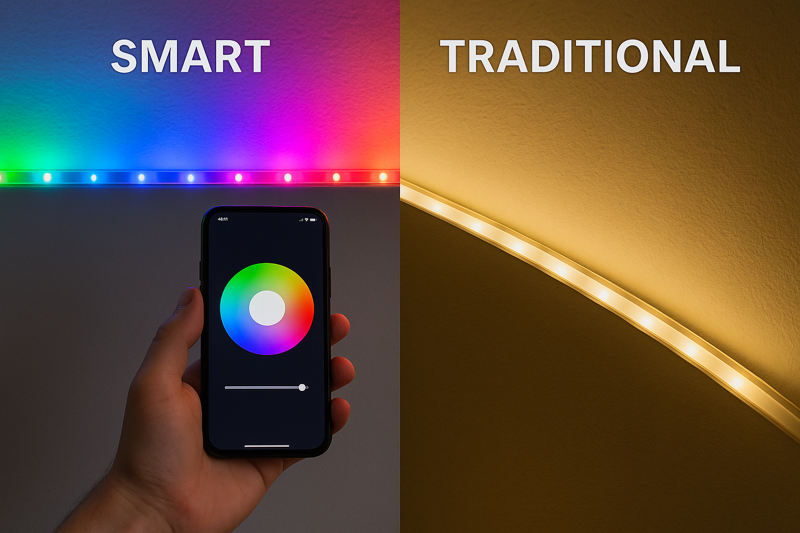
Your client wants dynamic, color-changing lights for their patio. But you’re worried about relying on Wi-Fi and apps for an outdoor installation that needs to be absolutely dependable for years.
Smart LED strips offer advanced control over colors and schedules, ideal for dynamic entertainment lighting. Traditional strips offer superior reliability and simplicity, making them the professional choice for essential architectural and safety lighting where failure is not an option.

From where I stand in the factory, I see both types of systems being built. The key isn’t that one is "better," but that they are designed for completely different jobs. A professional needs to understand the fundamental trade-offs between dynamic features and rock-solid field reliability. This guide will clarify which system is right for your next project.
What’s the Difference in Control and Functionality?
You need to provide your client with a lighting solution. But are you installing a simple light switch, or are you becoming their on-call IT support for a complex app and network?
Traditional strips offer simple, reliable on/off/dimming control via a hardwired switch or dimmer. Smart strips offer dynamic control over millions of colors (RGBW), scheduling, and special effects, all managed through a smartphone app or voice assistant.

The choice here comes down to the project’s primary function. Is the light a utility for safety and ambiance, or is it a feature for entertainment? For most architectural and landscape lighting, the bulletproof simplicity of a traditional dimmer is the right call. Smart controls are fantastic for a patio or pool area where the client wants to create different moods.
Control Methods and Capabilities
The user experience and feature set are worlds apart between these two systems.
The Power of Smart Control
A smart system’s brain is its controller, which connects to a Wi-Fi network. This unlocks a huge range of features managed from an app. Users can select any color imaginable, sync lights to music, create custom scenes (like "Movie Night" or "Party Mode"), and set complex schedules, such as having the lights turn on to 50% warm white at sunset and turn off at midnight. They can also integrate with voice assistants like Alexa or Google Assistant for hands-free control.
The Simplicity of Traditional Control
A traditional system is beautifully simple. The LED strip is wired to a power supply, which is often controlled by a standard, hardwired low-voltage dimmer or a simple on/off switch. Its function is direct and unambiguous. There are no apps to update, no passwords to forget, and no Wi-Fi signals to drop. It provides basic, but extremely reliable, control over brightness and power state.
| Feature | Traditional System1 | Smart System2 |
|---|---|---|
| Control Method | Hardwired Switch/Dimmer | App, Voice Assistant, Remote |
| Color Options | Single Color or Tunable White | Full RGBW (Millions of Colors) |
| Scheduling | Basic (with external timer) | Advanced In-App Scheduling |
| Special Effects | None | Music Sync, Fades, Scenes |
How Does Installation Complexity Compare?
You’re on a job site, and time is money. Do you want a straightforward wiring job that’s the same every time, or a multi-step process that might involve troubleshooting your client’s home Wi-Fi network?
A traditional strip installation is a simple electrical task: line-voltage to power supply, low-voltage to strip. A smart installation adds an IT task: you must also wire, power, and pair a digital controller, then connect it to a Wi-Fi network and set it up via an app.
Your company’s reputation depends on your installations working perfectly for years, not just months. Can you afford to risk callbacks because an app stopped working or a complex controller failed in the heat? Traditional systems are fundamentally more reliable. They contain fewer electronic components and have a single point of failure: the power supply. Smart systems introduce multiple potential failure points: the power supply, the controller’s sensitive electronics, Wi-Fi connectivity, and the software itself. This is the most critical question for a professional buyer like Tom. While smart features are exciting, reliability is paramount. The outdoor environment is harsh, with extreme temperatures, humidity, and moisture. The simpler a system is, the less there is to break. A high-quality, UL-listed traditional power supply is a sealed, robust piece of hardware designed for a decade of service. A smart controller is a miniature computer that is far more sensitive to environmental stress. A reliable system is one with the fewest things that can go wrong. The beauty of a traditional system is its lack of complexity. The power supply is the only active electronic component. If the light doesn’t turn on, that’s almost always the problem, making troubleshooting simple. There are no software bugs, no connectivity issues, and no cloud-based dependencies. It will work just as well in ten years as it does on day one. Smart systems are more fragile because they are more complex. A failure can occur in many places: Your client’s budget is a key factor. How do you explain the higher upfront cost of a smart system, and in what situations does that extra investment actually deliver real value? Smart systems cost more due to the complex controller. This cost is only justified when the project’s primary goal is entertainment and dynamic color control, such as for patios, pools, or holiday lighting. Traditional systems are more cost-effective and are the right choice for most architectural lighting. I advise my clients to think about the "why" behind the light. If the goal is to highlight a building’s architecture, provide safe illumination on stairs, or create a warm, ambient glow in a garden, traditional warm white light is not only more cost-effective but also more timeless and elegant. If the primary goal is to change the mood for parties or events, then the extra cost of a smart system is a worthwhile feature. Choosing the right technology is about aligning its cost and benefits with the client’s goals. The higher cost of a smart system pays for its versatility and "wow" factor. It’s the perfect choice for: The lower cost and higher reliability of traditional systems make them the professional standard for foundational lighting tasks: Choose a system based on the job. For reliable, foundational lighting, the simplicity and durability of a traditional system is the professional choice. For dynamic, color-rich entertainment spaces, smart systems deliver unmatched control. Learn why Traditional Systems are favored for their reliability, simplicity, and ease of use without the need for technology. ↩ Explore the advantages of Smart Systems, including convenience, customization, and integration with modern technology. ↩ Understanding Smart Controllers is essential for modern electrical setups, enhancing efficiency and control. ↩ Learning about Network Configuration can help ensure seamless integration of smart devices in your home. ↩ Understanding points of failure in smart systems can help you troubleshoot and improve reliability. ↩ Exploring the impact of dependencies on smart systems can enhance your knowledge of their vulnerabilities. ↩ Learn why Traditional Systems are preferred for reliability and cost-effectiveness in foundational lighting. ↩ Explore how Smart Systems enhance home automation with versatility and modern features. ↩ Smart Controller3, Strip
Smart Controller3, Strip
Required Skills
Electrical Wiring
Electrical Wiring + Network Configuration4
Setup Time
Faster, more predictable
Slower, potential for troubleshooting
Dependencies
None
Reliant on Client’s Wi-Fi Network
Which System Is More Reliable for Long-Term Outdoor Use?

Analyzing Points of Failure
The Robustness of Simplicity
The Vulnerabilities of Smart Systems
Factor
Traditional System
Smart System
Points of Failure5
Minimal (Primarily Power Supply)
Multiple (PSU, Controller, Wi-Fi, App, Cloud)
Lifespan
High (Built for durability)
Lower (Sensitive electronics)
Troubleshooting
Simple and direct
Complex, may require IT skills
Dependency6
Self-contained
Relies on external network and services
When Does Smart Justify the Cost Over Traditional?
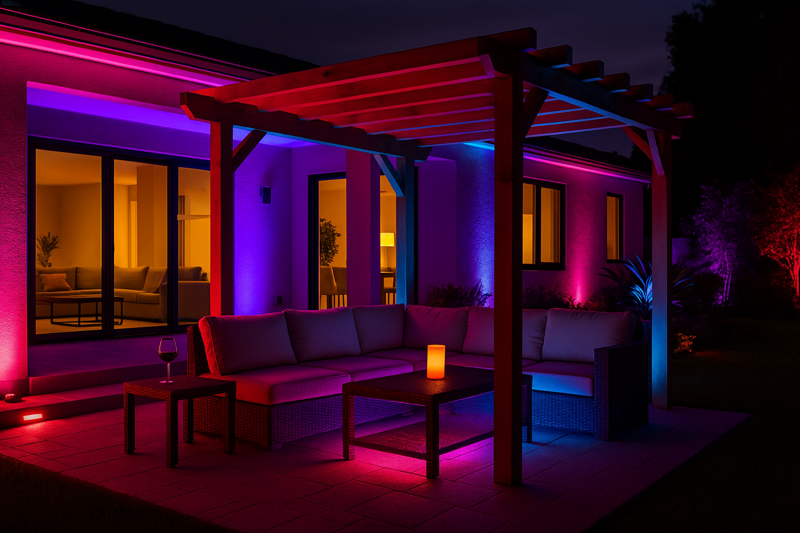
Matching the System to the Application
Best Use Cases for Smart
Best Use Cases for Traditional
Application
Traditional System7 (Recommended)
Smart System8 (Consider)
Architectural
Yes (Cost-effective, reliable)
For specific color-wash effects only
Safety/Task
Yes (Always on, dependable)
No (Overly complex)
Ambiance
Yes (Elegant, timeless)
Yes (For color versatility)
Entertainment
No (Limited features)
Yes (Ideal for this purpose)
Conclusion
Related Articles
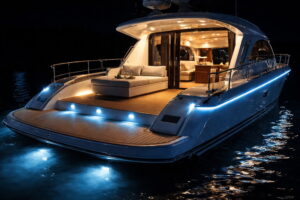
Why Do Most Marine LED Strips Fail After One Season?
You install a beautiful lighting package on a client’s yacht. Three months later, the lights are flickering, the white silicone…
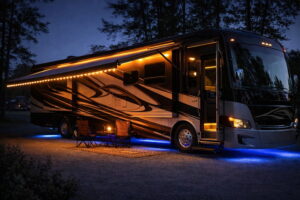
How Do You Choose RV LED Strips That Won’t Peel Off or Flicker on the Highway?
You are upgrading a $100,000 motorhome for a client. They want underglow lighting and awning lights to be the envy…
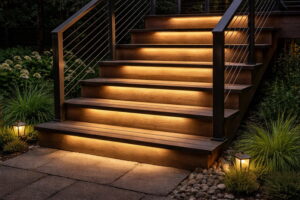
How Can You Light Outdoor Stairs for Maximum Safety Without Blinding the Homeowner?
You have finished a beautiful tiered deck or a stone landscape staircase. The client wants lights. If you do this…
